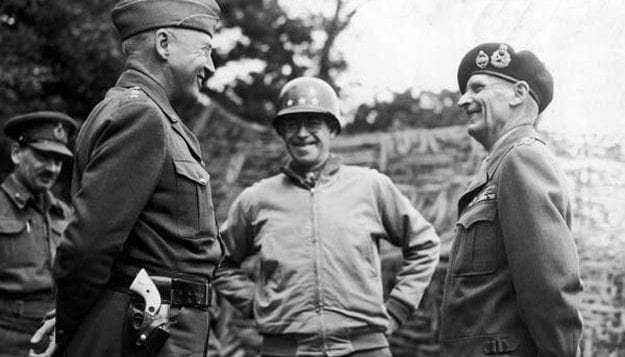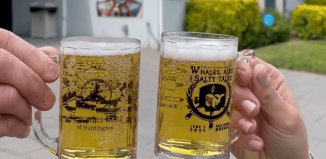Fighting on Independence Day, 1944
Allied troops in WWII fought through thick casualties the week of July 4, 1944

By Rich Acritelli
As Americans enjoyed a beautiful Independence Day with the opportunity to watch ball games, barbecue, go swimming and enjoy fireworks, at this time of year and in the many years prior, our nation has always preserved freedom during times of peace and war. Today, American military forces are in every corner of the world serving in Afghanistan against the Taliban, at the Korean Demilitarized Zone and through an expanded naval and air power in the Persian Gulf to guard against potential Iranian aggression. But around this time, many decades ago, American soldiers spent their July 4 weeks overseas in active conflict.
These military actions were seen during the weeks that followed the D-Day landings at Normandy, France, on June 6, 1944. While the casualty estimates were far less than what was expected by Gen. Dwight D. Eisenhower, he did not expect the terrible warfare that was waged against his forces as the Allies moved inland from the beaches. The Germans masterfully utilized the French terrain of the “hedgerows” to slow down the mostly American, British and Canadian forces. For a time, Hitler still expected the main assault to be led by the controversial, but powerful presence of Gen. George S. Patton’s tanks at Calais. At this moment, Hitler’s senior generals widely protested against his belief that Normandy was only a secondary assault. Hitler wasted precious time and committed serious military blunders by not adhering to their advice to wage a counterattack against the invading forces who were pushing out from Normandy. The German Wehrmacht had 19 divisions and 800 tanks that were waiting for an assault that never took place at Calais. This powerful force played no major role in attacking the earliest actions of Eisenhower during the opening stages of liberating France.
As the Allies pushed forward from the beaches, Hitler ordered the use of the V-1 and V-2 rockets that established a new “blitz” against London. Unlike the German bombers and fighters that reigned havoc on the city earlier in the war, there was little defense that could be conducted against these “buzz bombs” that terrorized the British civilians toward the end of the war. Again, Hitler’s senior generals stated that if these weapons were to be used, they should be deployed against the Allied ports in England that shipped over a tremendous amount of resources to aid their soldiers in France. However, Hitler believed that it was entirely possible for these “wonder weapons” to achieve a victory for Germany, even though the Allies were militarily established in France.
The German dictator refused to adhere to any military information from his generals who continued to tell Hitler that the situation was bleak. As Eisenhower had to deal with setbacks from the hedgerows, he knew that it was only a matter of time before his forces could break out against the Germans who were barely holding their own ground. Hitler refused to realize how desperate the situation in the west was. He decreed that every inch of this ground should be contested, that his soldiers should fight to the bitter end to cause horrific casualties against Eisenhower, which he hoped would move the Allies to withdraw back to England. Hitler’s once favorite leader, Field Marshall Erwin Rommel, observed that it was not possible for Germany to defeat the superior resources that Eisenhower had at his disposal. Rommel pleaded with Hitler to end the war on the Western Front to prevent utter defeat and destruction. Rommel understood that while the Allies were marred by the terrain, it was only a matter of time before Patton pushed eastward toward Paris. Hitler scolded Rommel, saw him as a defeatist, and refused to adhere to any talk of ending the war and making peace.
Like Rommel, a disgruntled Field Marshal Gerd von Rundstedt understood that the hedgerow fighting would be overcome by the Allies and there was no chance of victory. After he was relieved by Hitler, he told his military peers, “Make peace you idiots,” before all is quickly lost. About two weeks after July 4, 1944, a small group of German military and civilian leaders carried out an assassination attempt of Hitler at his headquarters in East Prussia. Rommel was tied to this failed plan and he was given a choice by Hitler to stand trial or commit suicide. To protect his family, he took his own life under the fake deception that Rommel died from wounds that he received from an Allied aerial attack against his car.
Even as Eisenhower had the upper hand against Hitler, his forces endured terrible losses against the German defenses. It hurt the Americans and British that the poor weather, which had stymied Eisenhower’s D-Day decision about when to land at Normandy, carried over during this campaign. The Allies had a difficult time coordinating air support against enemy positions through heavy rain and clouds. During the early days of July, the American military had 27,000 casualties among its 413,000 soldiers. Resembling the warfare that Gen. Ulysses S. Grant saw against Robert E. Lee in the 1864 fighting in Virginia, the Germans used the thick natural growth of trees, bushes and terrain to their bloody advantage. In order to support these operations, Eisenhower needed to have a large harbor to collect the vital supplies that were used on a daily basis by his men. By July 1, 1944, the French port of Cherbourg was taken, which allowed Eisenhower to bring in an additional 1,566,000 soldiers, 333,000 vehicles and 1.6 million tons of food, equipment and ammunition.
General Omar N. Bradley commanded all of the American ground forces and he was shocked at the extreme losses that his army sustained. “The G.I.’s General,” as Bradley was known by his men, believed that Allied movements progressed at a “snail’s pace” against the enemy. Both Bradley and Eisenhower relied on the aggressiveness of Patton’s efforts to push his armor inland to create weaknesses and chaos within the German lines. The brief hedgerow warfare frustrated the American desire to hit the enemy hard and use their advantages to coordinate air and land warfare. As Patton was disciplined by Eisenhower during the “slapping incident,” in Sicily, they desperately sought his armor tactics to end this stalemate and push the enemy back on their heels.
It was almost 75 years ago this week that American military forces moved slowly against the determined resolve of the German army to push forward beyond the Normandy landings. While the war would be over within a year and Hitler’s Third Reich would be completely destroyed, American soldiers endured high casualties within the first stages in liberating Western Europe of Nazi control. At a time when the German military had slowed down Allied advances, even their key military figures understood that they could not match the strength of Eisenhower and the war machine that was created to defeat them during July of 1944.
Rich Acritelli is a social studies teacher at Rocky Point High School and an adjunct professor of American history at Suffolk County Community College.






